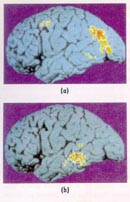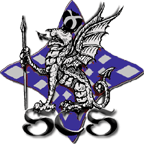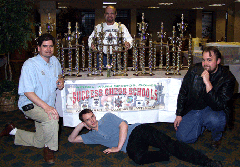 |
 |
Let me start
with this actual PET scan. PET scans allow scientists to identify
specific brain areas that are activated bydifferent tasks. Here
researchers have used PET scans to identify the brain areas
stimulated in the complex mental activities during a chess game
(Nichelli and others, 1994). In scan (a), areas at the back of the
brain, where visual information is processed, are most active when a
player distinguishes between black and white chess pieces. In (b),
the lower middle region of the brain is more active when a player is
determining if a particular chess piece can capture another
piece.*
And,
so our theme: "Fun while using your brain!"
*Don
Hockenbury and Sandra Hockenbury, Psychology, New York: Worth
Publishers, 1997, p.68. |
 |
Download SCS course outlines in pdf: 
Beginner's
Course Outline
Intermediate
Beginner's Course Outline
Advanced
Beginner's Course Outline
Advanced
Player's Course Outline
Experienced-Tournament
Player's Course Outline
Download skills test on what student should know:
From
Beginner's Program
Download 30 Rules (Guidelines)
of Playing Good Chess:
Thirty
Rules of Chess
How to play chess for beginners and
parents - Magic Theater:
How
To Play Chess
Review some instructive games taught in
our advanced program:
43
Blue Knight Games
A study guide for tactical
players:
A Purdy Method of
Chess
Extra-credit homework--Student
ID needed!
ChessHomeWork.com
See a list
of SCS Instructor Recommended Books and CD-Roms
From Richard
Shorman
From Henry
Vinerts, USCF Expert--Annotated
 Left: SCS coaches with the trophies
their Left: SCS coaches with the trophies
their
teams won at the CalChess State Scholastic Championships on
April 6 & 7, 2002. The tournament drew 1100 players to the Monterey
Conference Center. SCS players and schools dominated almost every division
and proved the success of their chess program.
Our History and Our
Program
(from SCS founder, Dr. Alan Kirshner):
I would never have
suspected in a million years that when I volunteered to create an
after-school chess club at my son's elementary school eleven years ago
that I would still be running the club when he was a senior in high
school. In the summer of 1988, my son, Micah Fisher-Kirshner, ready for
first grade at Weibel Elementary School in Fremont, California, entered a
local library chess tournament. Ray Orwig, a chess coach and Senior
Tournament Director, ran a number of these non-US Chess Federation
tournaments in the San Francisco Bay area. During the year, he also held a
number of US Chess Federation, matches including the Northern California
State Scholastic Championships.
My son enjoyed the library
tournament so much that I decided it would be nice if he could have a few
other children to play chess with after school. I started out with about
eight children from Weibel Elementary School and three from a nearby
school, Mission San Jose Elementary. Today that small Weibel club has
grown to 135 children, a 40-person waiting list and five paid instructors.
Mission San Jose, a smaller school than Weibel, has about 50 members in
its chess club and continues with parent volunteers. Inquires from other
parents has enabled chess in Fremont to expand to five other schools
averaging about 70 children in each program. Some have hired Weibel chess
teachers through family or Parent Teacher Association
contributions.
While only a few of our Fremont children have been
on the USCF Top 50 list for their age group and our schools have won few
National Championships (Mission San Jose won the National Grade Level and
Hopkins Junior High School won the K-8 Championship Division in 1996), the
excitement of chess continues to explode in this area. Perhaps this
explosion is because our emphasis has been on the art, the proven
educational value and the fun of the game.
Last year, one of my
Weibel players asked me why I continued to run the club when my son was
now in high school. I answered him, "that without the support of the
parents and their willingness to volunteer their time in a myriad of
different ways there would be no chess in Fremont."
Time to get to
the when, what, where and how of this program: In March of 1989, Micah in
first grade won our stateās K-3 championship division. I learned of the
National Elementary Championships being held in Tempe, Arizona in April. I
thought it would be fun to try, and was not sure I could afford to attend.
However, a colleague of mine raised the funds and paid the way for my two
sons and myself. What an experience!
At Tempe, in 1989, numerous
booksellers and chess entrepreneurs exhibited their products. Sadly, this
was not to be the case at future Nationals. I bought everything I could
find on organizing a scholastic chess club. DeWain Barberās pamphlet, A
Guide to Scholastic Chess, that the US Chess Federation provides free,
proved a great start. And, so did the five free tournament chess sets I
obtained from the Chess Federation's Trust. But, equally valuable were the
insights I obtained from talking with fellow parents who also ran chess
programs at their schools. So, I returned to Fremont loaded down with new
ideas from chess instructors and educators. And over the years I have
continued to keep my ears open to any suggestions on how to build a
scholastic chess program.
I believe the three most productive
concepts at Weibel for maintaining interest in chess and producing good
chess players has been our hands-on approach to learning, peer instruction
and an extensive system of rewards. All of our students have their own
chess sets. At first we used full size tournament sets, but as our numbers
increased we moved to pocket sets for each player. In recent years, we
have gone back to tournament sets, as we break the club into two days, one
for Team and one for Club. Since I now have the help of other instructors,
we can break these groups down into smaller sections based upon ability,
and the school has given us more classrooms. The PTA first purchased the
boards and pieces, but presently parent contributions and funds from chess
tournaments that we run supply all our equipment needs. In recent years,
we have even been able to donate equipment to the teachers and extra funds
to the PTA.
When the children are taught something with the
traditional demonstration board, with a small group around a teacher, or
using computers hooked up to projection TV's, they are asked to move the
pieces on their own boards. They repeat each lesson on their own and then
demonstrate the lesson, such as checkmating with a king and a rook vs. a
king, to a classmate.
I would like to take an aside here and
describe the Club and Team approach at Weibel. At the beginning of each
year children are asked if they want to be in the Club for fun or the Team
for competition (and fun, of course). Team members must commit to
attending three USCF tournaments during the year (girls must play in the
CalChess Girl's Tournament as one of their tournaments), playing in the
CalChess State Scholastic Championships and doing a minimum of 2 1/2 hours
of chess homework per week. In contrast, the Club members have no
commitment other than to attend our lessons. Team members meet for an hour
and a half with 30 minutes of instruction and an hour of tournament style
play. The Club members receive 20 minutes of instruction and play chess
for 40 minutes. We make no decision as to who will be on the Club or the
Team; that is left to the children (well, in reality, the parents). This
year we had 55 children from K through 6th grade on the Team and 80
children participating in the Club, most of whom were in the lower school
grades. We have 40+ children on our waiting list each year, as space is
limited. The number of chess players in our program constitutes about 22
percent of the students at Weibel, and one-third are girls. I am happy to
report that the dropout rate for the girls is no different than for the
boys, and for both the numbers are very low.
At the beginning of
each year, we have about 40 new students who have limited if any knowledge
of the game usually about ten of them are in kindergarten. Our more
knowledgeable students become our chess aides. We provide the lecture, and
the teaching assistants (other students) work one-on-one with the new club
members. This usually lasts for about eight weeks, when we then divide the
class into smaller groups based upon ability.
Our reward system is
extensive, effective and really simple. The children respond beautifully
to positive feedback and little goodies. Handshakes for good
participation, chess stickers (made on the computer), certificates and an
in-house rating system works wonders for our students self-esteem and our
97% retention rate. This year we had a special pizza and ice-cream party
for the Team's tenth straight year winning a state championship
title.
Let me describe our rating system, as it has proved the most
effective motivation for the children. We award points for winning a game
(3), drawing a game (2) and losing a game (1). If the children attend USCF
tournaments, these points are doubled. They obtain points for doing
homework (on the Team this would be any homework above the minimum
required per week) and for helping other students with their learning.
After obtaining eight points they receive the rank of Pawn. After
obtaining 16 points they become a Knight, and so forth. A few students
have obtained the title of Weibel's Gary Kasparov, obtaining 1,150 or more
points accumulated over the years. Each week all the students receive an
updated rating sheet and each month the parents receive progress reports.
Children love collecting these sheets and announcing out loud how they are
now, for example, a Queen.
The points are cumulative over the
years. Five players in the Club and five players on the Team are given
special recognition at our year-end potluck awards banquet for obtaining
the most points in that year. All Weibel chess members receive trophies at
this ceremony plus a colorful certificate recognizing the title they have
earned. We also present numerous door prizes at the banquet, from chess
key chains to chess computers. Winning a prize depends only on the luck of
the draw, and very few players go home empty handed.
I am willing
to answer any questions that would provide assistance. You can contact me
at AKirshner(Alan
Kirshner)@ohlone.cc.ca.us.
School Mates, official
youth magazine of the US Chess Federation published this article in their
November/December 1999 issue.
home
program
instructors
mailing
lists
|




